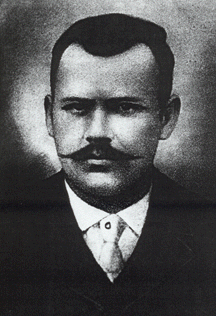|
With one major exception, the story at the right for many years was what this family knew about their ancestor Georg Friedrich. During the summer of 2000, Mark Ollenburger, grandson of the man pictured at right, was inspired to search the Grunau rather than the mother colony records for his grandfather's birth record. And he found it! But more than that, he discovered additional information which led to a more complete story confirming many of the elements in the family lore and explaining the mystery of Georg's childhood.
Georg Friedrich was indeed the surviving twin. His older brother, unnamed, was stillborn. A poignent account of the burial was included in the record. The surviving twin was not named for several weeks, indicating that either the life of the child or the mother was in jeopardy. Georg Friedrich, son of Georg Friedrich, was born into a family which already had three daughters, as well as mother and father. Within the first 3 years of Georg's life, his sisters Maria Elisabeth, Maria Catharina, and Catharina, and then his mother Johanna Elisabeth Catharina Kaftan Ollenborger all died. Georg the elder remarried a Buchmeuller woman; after all, there was still a toddler in the house. Then, unbelieveably, before the young Georg was 5, his father also died. This story is the sequence of events gleaned from the Grunau parish records. They, however, do not tell about the inheritance or how the child Georg made his way to Krim. It is speculated that Georg's stepmother took him with her, appearing to have returned to her own family.
|

Georg Friedrich was born 8 December, 1871 in Kaltschinowka, Grunau, Russia. He had a twin who died at birth. His parents died in his youth and he was raised by relatives. He inherited his parents' entire estate. At some later time, he moved to Byten in Neusatz, Krim. (Crimea). He was a master mechanic (Meister Mechaniker, or blacksmith). He was renowned for his work. Among other things, he made a spring buggy under contract for the royal family in Russia (Czar Nicholas II). He had twelve men in his employ.
He married 16-year-old Marie Elisabeth Reimche when he was 20. The day after the wedding they left for a year-long honeymoon to Canada and America; they stayed until October, 1894, when they returned to Byten/Bolozciew in Krim (the Crimea). During their time in America, they visited friends and relatives in Canada the United States. They spent time visiting relatives in Wittenberg, South Dakota, a Mennonite enclave. Georg Friedrich had already served in the Russian army and didn't want to go back. The family left Russia because conditions were worsening, on the eve of the revolution. The machine shop was sold in 1908 and they left for America in 1911.
They went by rail to Libau / Lebau, Lithuania, then to Liverpool, England by boat and on to Quebec, Canada on the Pommerania, arriving 8 Sept 1911. They travelled by rail to McClean, Saskatchewan and arrived in North Dakota on 7 Nov 1911. Official Port of Entry documents cite both Pembina and Portal, North Dakota as points of entry. They went to uncle Reverend Ludwig Seibel who had prepared a place for them to stay in McClusky, North Dakota. Later, they moved to Underwood, North Dakota and later to Wilton, North Dakota where Georg worked as a section foreman for the Soo Railroad. The family never heard of "Ollenburgers" again. Georg died on Armistice Day 1918, from double pneumonia after having the Spanish Influenza during the great pandemic.
|

